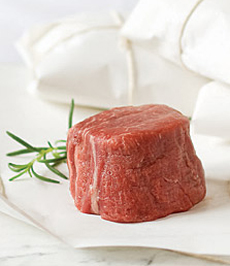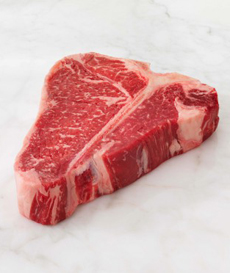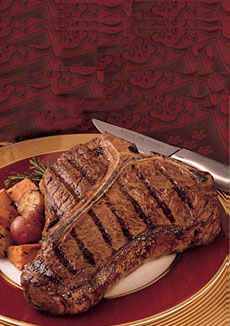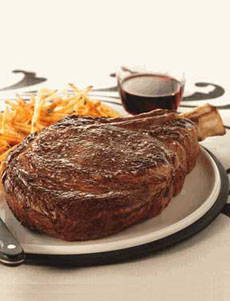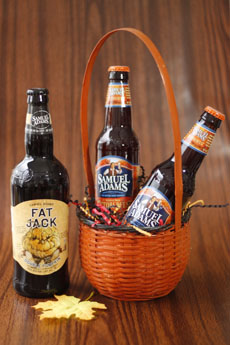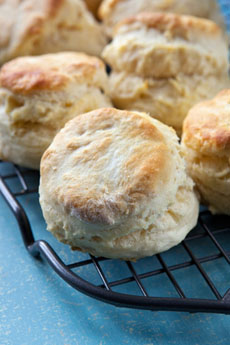
[1] Mmm, hot biscuits (photo © Robyn Mac | Fotolia).
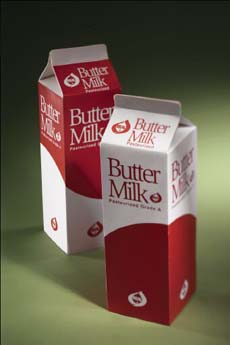
[2] See what to do with leftover buttermilk, below (photo © Wisconsin Cheese).

[3] If you only need a bit, you can make your own buttermilk. See how in the footnote† below (photo CCO Public Domain).

[4] You can enjoy a glass of buttermilk plain, or with some fresh herbs like cilantro, dill, or parsley (photo CCO Public Domain).

[5] A jar of Sarabeth’s preserves is a treat for biscuits and a welcome small gift. Here, peach apricot preserves (photo © Sarabeth’s).
|
|
Centuries ago cooks discovered that the acid in buttermilk reacts with baking soda to produce carbon dioxide bubbles. Buttermilk became a must-have ingredient to create light, tender, highest-rising biscuits, bread and muffins, pancakes, and layer cakes.
It’s Sunday and September is National Biscuit Month. What more worthy activity is there than baking a batch of biscuits for breakfast, lunch, or dinner?
Up until the mid-20th century, many families who had cooks (or very energetic moms) looked forward to hot buttermilk biscuits at the breakfast table.
This recipe, from specialty food doyenne Sarabeth Levine, goes equally well with fresh butter or with Sarabeth’s delicious jams and preserves (we’re particularly fond of her blood orange marmalade).
Do you remember this tongue-twister from childhood: A batch of biscuits/a batch of mixed biscuits/a biscuit mixer? Say it several times quickly.
Then, check out this recipe and whip up some fragrant, tender biscuits.
> May 14th is National Buttermilk Biscuit Day.
> The history of biscuits and the difference between biscuits and rolls.
SARABETH’S BUTTERMILK BISCUITS
Did you know that you can make buttermilk from regular milk, just by adding lemon juice or vinegar? See the instructions in the footnote† below.
Ingredients For 16 Biscuits
3¼ cups unbleached all-purpose flour
2 tablespoons superfine sugar
1 tablespoon plus 2 teaspoons baking powder
1/8 teaspoon fine sea salt
12 tablespoons (1½ inch sticks) unsalted butter, chilled, cut into ½ inch thick cubes
1½ cups buttermilk
Preparation
1. PREHEAT. Position a rack in the center of the oven and preheat to 400°F. Line a half-sheet pan with parchment paper.
2. SIFT & MIX. Sift together the flour, sugar, baking powder, and salt in the bowl of a heavy-duty stand mixer. Attach the bowl to the mixer and fit with the paddle attachment. Add the butter. Mix on low speed until the mixture resembles a coarse meal with some pea-size pieces of butter. Add the buttermilk, mixing in just until the dough barely comes together.
3. KNEAD. Scrape the dough onto a lightly floured surface and knead a few times until the dough is smooth. Sprinkle the top of the dough with flour and roll it out to ¾ inch thick or slightly thicker.
4. CUT. Using a 2-¼ inch fluted biscuit cutter (you can substitute a round cookie cutter), dipping the cutter into flour between cuts, cut out the biscuits and place 1 inch apart on the pan. Gently press the scraps together (do not overhandle the dough). Repeat rolling and cutting.
5. BAKE. Bake until the biscuits are well risen and golden brown, 18 to 20 minutes. Serve hot or warm. To reheat the biscuits, wrap them in aluminum foil and bake in a preheated 350°F oven for about 10 minutes.
WHAT TO DO WITH LEFTOVER BUTTERMILK
Many people who buy buttermilk for baking lament that it only comes in quarts, not pints. A cup is generally enough for any recipe. Buttermilk is expensive.
But you don’t need to waste the leftover buttermilk.
Drink It
If you like yogurt or kefir, buttermilk has similar flavors. If you don’t like yogurt, you have friends who might appreciate the buttermilk.
Freeze It
In our recent article on other things to do with your ice cube tray, we suggested freezing buttermilk.
Measure how many tablespoons of liquid go into each compartment of your ice cube tray (you don’t need to fill the compartments to the brim, as with ice cubes).
Then, fill with the leftover buttermilk. When the milk is frozen, remove the cubes to a plastic freezer bag and mark the tablespoon equivalent on the bag.
The next time you need buttermilk for a recipe, it defrosts easily on the counter or in the microwave. Four tablespoons equal 1/4 cup, so you may want to freeze in two-tablespoon portions.
Substitute It
Buttermilk can also be substituted for whole milk or skim milk in many recipes, from baked goods, frozen desserts, and puddings to sauces and soups.
Use It In A Marinade Or Breading
The acidic properties of buttermilk make it a tenderizing and flavorful marinade. Hunters soak fresh venison in buttermilk overnight to reduce the gamy taste.
Also use it to adhere to the breading for fish, meat, and poultry.
|





